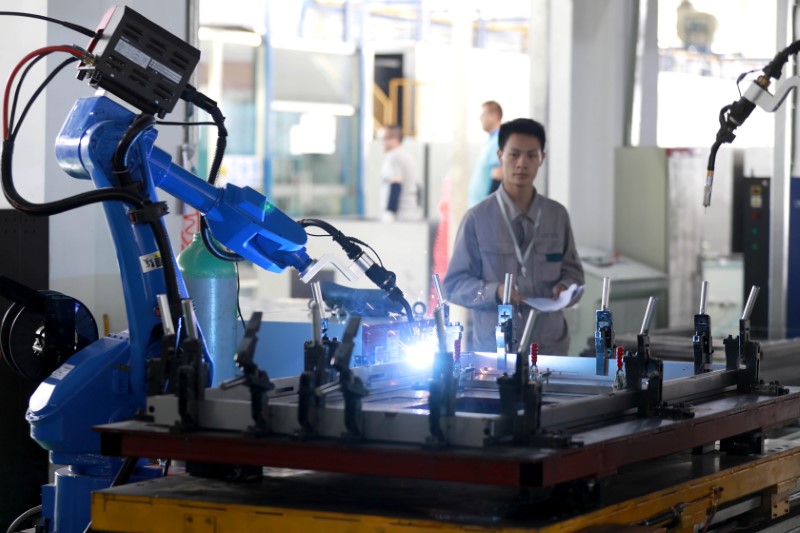BEIJING (Reuters) - China's growth looks set to cool further in coming months, with a barrage of August economic data doing little to dispel views that domestic demand is softening and government support measures will take some time to kick in.
While industrial output and retail sales readings on Friday were better than expected, most other indicators over the past week were more downbeat, with a key investment gauge falling to a fresh low and broad credit growth the slowest on record.
Two other bulwarks of the economy are also starting to look a bit shaky, with exports expected to succumb to the cumulative weight of U.S. tariffs and the property sector losing a step from July.
"We believe China's overall economy continues to slow, and this could worsen in coming months," economists at Nomura said in a note.
Nomura and other China watchers expect more growth-boosting measures from Beijing in coming months to cushion the economy and weather the U.S. trade war, but some warn high debt levels may give policymakers less room for stimulus than in the past.
BRIGHT SPOTS?
On the surface, two bright spots in the August data were industrial output and retail sales, which picked up more than forecast.
Most economists, however, believe the gains are unlikely to be sustained, with business conditions in the world's second-largest economy expected to get worse before they get better.
Industrial output rose 6.1 percent from a year earlier, the National Bureau of Statistics (NBS) said, a tick better than July.
Retail sales rose 9.0 percent, driven by jewellery and home appliances. Analysts had expected 8.8 percent, unchanged from July and not far from a 15-year low.
A closer examination of both data series, however, pointed to signs of underlying weakness.
Industrial exports looked solid, but analysts believe companies have been rushing out products, or "frontloading", to beat U.S. tariffs, raising the risk of a slump later in the year.
Production of key goods such as motor vehicles and transport equipment continued to decline. Output of cars barely grew, while steel mills, aluminium smelters and oil refiners all throttled back output from recent high levels.
Growth in hi-tech products like semiconductors and industrial robots also slowed sharply.
Auto sales, which account for a tenth of retail sales, fell 3.2 percent on-year as Chinese consumers turned more cautious.
INVESTMENT STILL SLUGGISH
Investment data - a key indicator of future activity - also pointed to a further loss of economic momentum.
Fixed-asset investment growth slowed to 5.3 percent in January-August, weighed down again by slowing infrastructure growth. Analysts polled by Reuters had expected 5.5 percent, the same as the previous all-time low hit last month.
For August, fixed-asset investment rose 4.6 percent, Reuters calculations showed.
Growth in infrastructure spending, a powerful economic driver last year, also slowed to 4.2 percent in the first eight months of the year, from 5.7 percent in January-July.
While Beijing has accelerated approvals for road and rail projects in recent months, a familiar tactic used in past downturns, analysts note it will take time for construction to begin and put a floor under weakening economic growth.
"Fixed-asset investment growth is expected to stabilise, but talking of a rebound I suspect the difficulty will be relatively big," said statistics bureau spokesman Mao Shengyong.
Private sector fixed-asset investment rose 8.7 percent in January-August, easing marginally but still a source of support. Private investment accounts for about 60 percent of overall investment in China.
Real estate, one of the few standouts on the investment side, also moderated as tight controls on the sector continued to take out speculative heat. While growth was still solid at 9.2 percent on-year, a sustained tail-off could sharply increase the risks to the economy, especially if the trade war worsens.
GROWTH BOOSTING MEASURES
With Washington ratcheting up trade pressure, Chinese policymakers have shifted their focus in recent months to easing credit conditions and shoring up business confidence.
In addition to ramping up spending, China is pumping more money into the banking system to bring down financing costs.
It is also urging banks to keep lending to smaller firms, but rising bad loans and defaults are making lenders cautious, complicating the central bank's policy push.
Top officials have vowed they will not resort to strong stimulus as in past slowdowns, a choice that boosted growth but fuelled a mountain of debt and systemic financial risks that regulators are still struggling to address.
But most economists suspect Beijing may start opening the taps wider in coming months if growth deteriorates sharply.
ING's Iris Pang believes the scale of fiscal stimulus this year and next will be equivalent to the massive support that authorities rolled out during the global financial crisis.
"Expect a total 5 trillion yuan fiscal stimulus for the rest of 2018, and another 5 trillion yuan of fiscal stimulus in the first half of 2019," she said in a recent note.
"Then the scale of around 10 trillion would be equivalent to then 4 trillion yuan stimulus in 2009," she said, noting the economy is far larger now.
